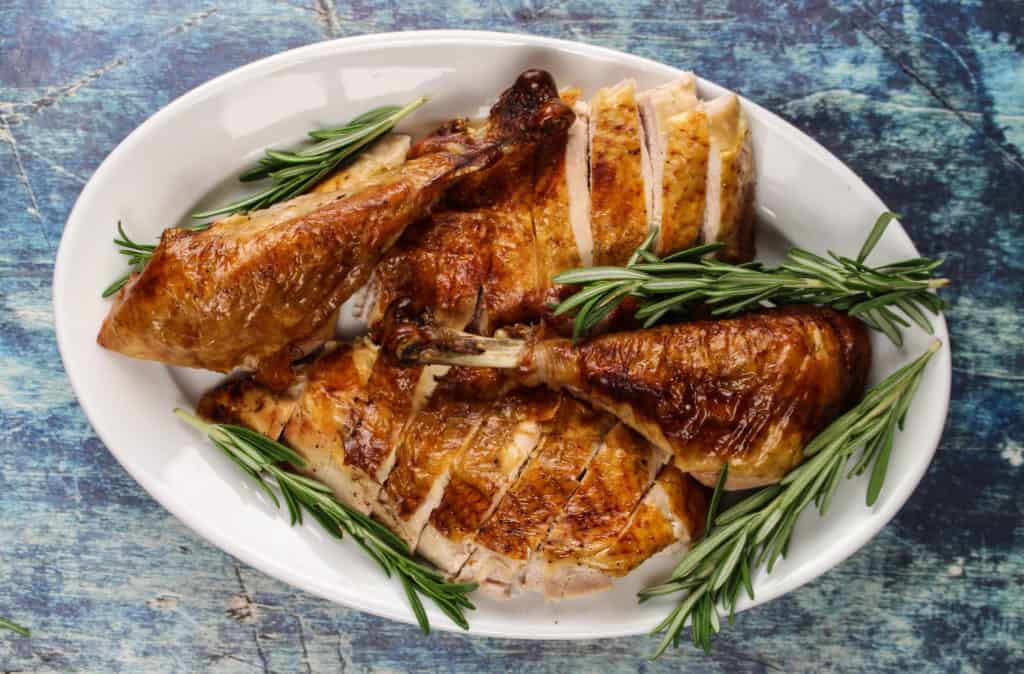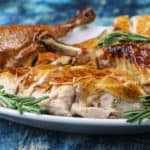Every year for Thanksgiving it seems I’m trying something different while cooking a turkey. I’ve not always been successful at keeping my turkey moist and flavorful. I’ve sadly overcooked my turkey too many times. I could tell by the sympathetic looks of my guests or their slow chewing that something is not quite right. Most people are too nice to say, “hey, your turkey is really dry”. I always hope that the side dishes, appetizers, desserts and cocktails make up for a lack luster turkey.
Over the years I have realized the brining the turkey seems to really help make a more flavorful and moist turkey. I have been using a salty brine with herbs and spices. This year I tried something different and added buttermilk to the salty brine mixture. I have finally found success in making a tasty and moist turkey.
The buttermilk brine helped the turkey stay moist and delicious. I know this recipe works because again I got distracted and kept the turkey in the oven too long again. I was freaking out a little when I put the thermometer in the turkey breast and it read 185°. I was thinking “CRUD! I ruined another turkey!” It should’ve been dry, dry, dry but it wasn’t. It still tasted delicious and moist.

Yipee! I was so proud of my turkey this year. It was surprisingly easy to make too! I hope you give this turkey recipe a try. Enjoy!
Juicy Buttermilk Brined Turkey
Ingredients
Buttermilk Brine:
- 4 cups water
- 3/4 cup salt
- 1 cup ice cubes
- 5 tablespoons dried basil
- 5 tablespoons coriander seed
- 2 tablespoons ground mustard
- 2 tablespoons black peppercorns
- 4 bay leaves
- 3 cloves of medium sized fresh garlic minced
- 3 quarts buttermilk
For Turkey:
- 1 fresh turkey 12 lb
- ¼ cup unsalted butter room temperature
Instructions
- Make the buttermilk brine by combining the salt, basil, coriander, peppercorns, mustard, garlic and bay leaves with the water in a saucepan over high heat. Bring to a boil, stirring occasionally until the salt is dissolved. Remove from the heat and let cool for 5 minutes. Add ice to the brine mixture and stir. Once the brine mixture is completely cooled, add 1 quart of buttermilk to the mixture and stir.
- Rinse the turkey inside and out with cold water and place in a large brining bag. Carefully pour the buttermilk brine mixture into the bag. Add the remaining 2 quarts of buttermilk and swish the mixture around the turkey. Seal the bag, pressing out the air, and place in a container large enough to hold the turkey. Refrigerate for 24 to 36 hours, turning occasionally.
- Remove the turkey from the brine; discard the brine. Rinse the turkey inside and out with cold water and pat dry with paper towels. In a large roasting pan, place the turkey, breast side up, on a rack. Rub the turkey skin all over with the butter. Tie the turkey legs together using kitchen twine. Let the turkey stand at room temperature for 1 hour.
- Position a rack in the lower third of an oven and preheat to 400°F.
- Roast the turkey for 30 minutes. Reduce the oven temperature to 325°F and continue roasting. Baste the turkey every 30 minutes or so using the pan juices. You may have to tilt the pan to get the juices at the bottom. If the breast begins to cook too quickly, tent it loosely with aluminum foil. After about 2 hours of total roasting time, begin testing for doneness by inserting an instant-read thermometer into the thickest part of the breast and thigh, away from the bone. The breast should register 165°F and the thigh, 175°F. The total roasting time should be 2 1/2 to 3 1/2 hours.
- Transfer the turkey to a carving board, cover loosely with foil and let rest for 20 to 30 minutes before carving. Enjoy!

